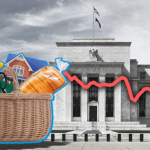Inflation Fell To 6.4% In January— as the cost of housing, food and gas rose
The U.S. Bureau of Labor Statistics released its latest report on the Consumer Price Index, the most widely used of the monthly inflation gauges, today. The data revealed that the all items index increased 6.4% over the past 12 months before seasonal adjustment.
Although it’s well below the 9.1% summer peak, the CPI suggests inflation is still quite high. But the supercore wage reading, which accounts for the price rises of a range of services — from haircuts to plumbing — has dropped off substantially, from an 8% annual rate in early 2022 to 5% in December, per the White House Council of Economic Advisers.
Key Takeaways:
- Annual inflation in January fell for a seventh straight month
but prices still rose more than economists projected since December
- Across-the-board increases in shelter, food and energy boosted the index after inflation had shown signs of receding in recent months
- Signaling inflation may take longer than previously thought to come down
- The Federal Reserve is still deciding how aggressively it should raise interest rates in order to tame prices
- “Super core” services inflation, which is key for the Fed and excludes food, energy and shelter, rose 0.2% for the month and was 4% higher than a year ago
Annual inflation in January fell for a seventh straight month but consumer prices still rose 6.4% on an annual basis—more than economists expected. The latest Labor Department data indicates inflation may take longer to ease than previously thought, which will influence the Federal Reserve’s economic policy.
According to Forbes, the new inflation data sent stocks tumbling Tuesday, ushering in volatility that many experts predict will only continue in the coming months due to uncertainty of rising prices and the Fed’s next moves.
Stubbornly high inflation means that the Federal Reserve is likely to keep raising interest rates, at least for the next few months.
CNBC reported that Rising shelter costs accounted for about half the monthly increase, the Bureau of Labor Statistics said in the report. The component accounts for more than one-third of the index and rose 0.7% on the month and was up 7.9% from a year ago. The CPI had risen 0.1% in December.
Energy also was a significant contributor, up 2% and 8.7%, respectively, while food costs rose 0.5% and 10.1%, respectively.
Rising prices meant a loss in real pay for workers. Average hourly earnings fell 0.2% for the month and were down 1.8% from a year ago, according to a separate BLS report that adjusts wages for inflation.
While price increases had been abating in recent months, January’s data shows inflation is still a force in a U.S. economy in danger of slipping into recession this year.
New economic buzzword “Supercore Inflation”
If “transitory” was the buzzword for inflation watchers in 2021, this year it’s “supercore.” We might be in a rolling recession right now, but what can we expect going forward?
Federal Reserve officials and economists are trying to figure that out by examining data in new ways, and one of the hottest terms in their lexicon is “supercore inflation,” which refers to prices that increase when workers get paid more for their labor, CNN reported.
Entrepreneur Mag reported that “the Fed focuses on supercore because it includes those prices that are more likely to be driven by the cost of labor, which the Fed can more directly impact through changes in interest rates,” Mark Zandi, Moody’s chief economist, told CNN, adding that supercore inflation is “still way too hot” but has started to cool off.
That’s why some Fed officials, including Powell, say they are looking more closely at core services inflation minus shelter prices — “super-core” — in determining the course of policy. That number rose 0.2% in January and was up 4% from a year ago.
It’s worth mentioning that the supercore inflation measurement doesn’t account for categories like housing, food and energy —a recurring expense for most households — which continue to experience price pressures.
Conclusion
There’s widespread belief that the economy could tip into at least a shallow recession later this year or early in 2023. However, the latest tracking data from the Atlanta Fed puts expected GDP growth at 2.2% for the first quarter, following a relatively strong finish for 2022. On Wednesday, February 15th, 2023 The consumer roared back last month with a 3% increase in retail sales spending that was the largest monthly gain in nearly two years, adding to evidence that U.S. economic growth picked up at the start of the year.











